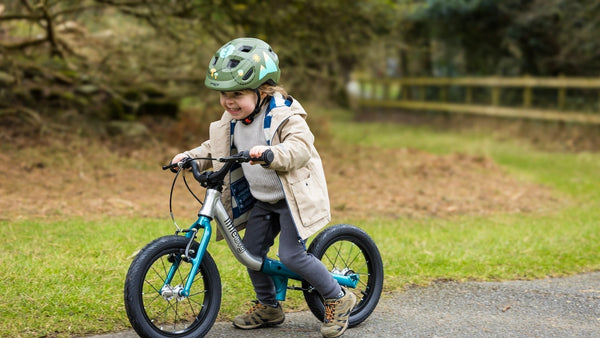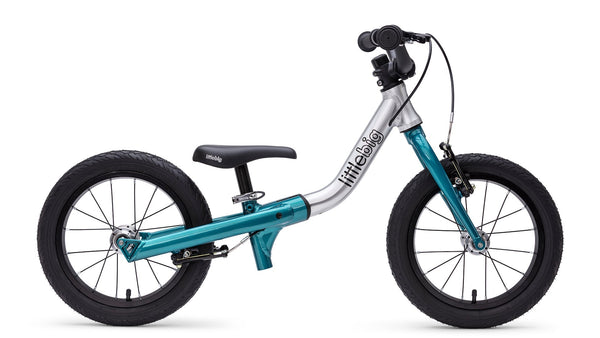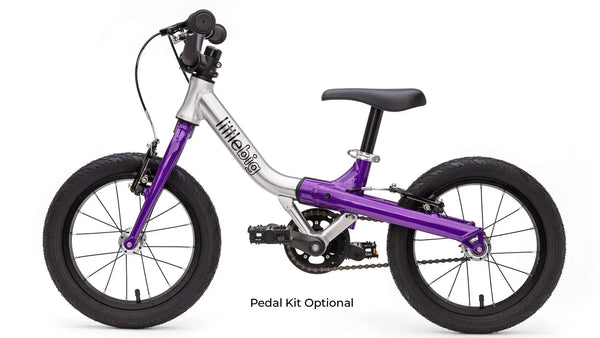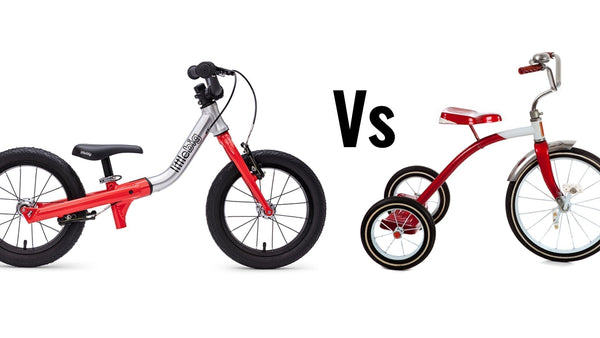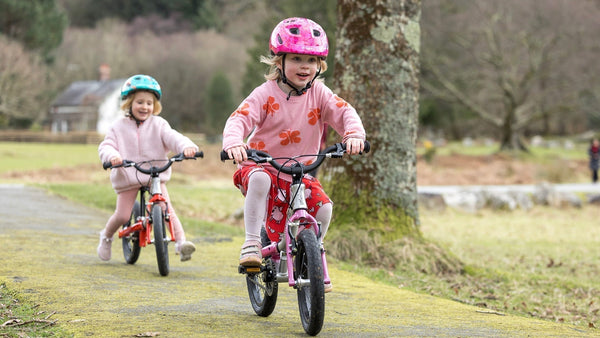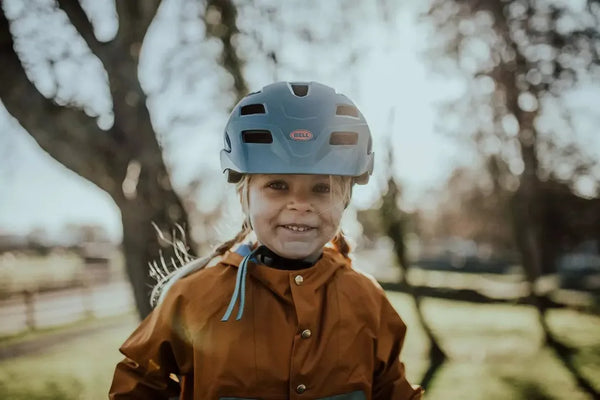10 reasons NOT TO use stabilisers on your kids bike
I recently saw two kids cycling together at the local BMX track; one was on a traditional pedal bike, the other was on a balance bike. While the kid on the balance bike had no trouble with the bumpy gravel surface, his friend kept toppling over and getting stuck on the humps. Although he was enthusiastic and just wanted to keep up with his friend, the problem was that he had stabilisers (AKA training wheels) fitted to his bike.
While stabilisers allow a child to begin pedalling and learning to brake immediately, studies have shown that it’s beneficial to learn to balance first.
1. Stabilisers Prevent A Child From Learning Proper Bike Balance
With stabilisers keeping the bike upright, your child misses out on learning the crucial skill of balance. When the stabilisers come off, they’re suddenly faced with the daunting task of balancing on their own. By contrast, a balance bike rider will learn to balance first, before progressing to pedals ensuring a seamless transition. Check out our in depth comparison on balance bikes vs training wheels, which is best?
It makes so much more sense to master balance first—building confidence and control before ever worrying about pedalling. It’s the perfect way to turn a daunting challenge into an exciting journey!
2. Stabilisers Don't Work Well on Rough or Uneven Ground
Stabilisers might keep the bike upright on a perfect, flat surface, but the moment your child ventures onto gravel, forest paths, or wet grass, those tiny plastic wheels can easily get stuck. It’s heartbreaking to see their excitement fade as the bike topples over on uneven ground or slopes.
Every adventurous rider will need the freedom to explore beyond the pavement!

3. Stabilisers are not the safest way to learn
Once the stabilisers come off, the transition from being supported by the stabilisers to being unsupported, can result in wobbles, crashes, and a loss of confidence.
After becoming comfortable with stabilisers, the transition to riding without them can be difficult for many children as they suddenly need to learn how to balance!
4. Stabilisers add extra cost
Stabilisers are an extra cost for the bike manufacturer, and unfortunately, that expense gets passed on to you. It’s frustrating to pay more for a feature that often hinders a child’s learning and enjoyment, especially when those costs could be better spent on a bike that truly supports your child’s journey towards confidence and independence on two wheels.
Manufacturers build their range of bikes to meet certain price points, and the cost of including stabilisers is potentially taking away from the quality of other parts on the bike.
Top Tip!
Our LittleBig convertible balance bike grows with your child so can last much longer than a standard bike, giving kids extra time to ride, saving money and is kinder to the planet.
5. Stabilisers Reduce A Bikes Agility
A bike steers by leaning, but stabilisers prevent the natural lean of the bike while cornering, which reduces the bike’s manoeuvrability and means the child can’t steer the bike as easily.
You only need to look at a Motorcycle Grand Prix to see how much the riders lean while cornering.

6. Stabilisers Cause Bad Habits
As the stabilisers stop the bike from leaning naturally inwards when turning, the rider needs to counteract this, a habit they will need to unlearn later.
Learning how to lean left and right to corner safely and effectively is a core cycling skill that is hindered by having stabilisers on the bike.
7. Stabilisers add extra weight
The lighter a bike can be, the easier and more enjoyable it will be to learn to ride on. Stabilisers add weight to the bike making it harder to get moving.
For what is an already unnecessary addition to the bike, it also reduces the handling and enjoyment a child will be able to get from it.
8. Stabilisers are cumbersome and noisy.
The hard plastic wheels generally rattle, scrape, and create a lot of noise. They are also flimsy (one regularly bends more than the other so the bike leans more on one side) which requires adjustment and can add complexity to keeping the bike running safely.
Bicycles are beautifully simple, two-wheeled machines. Adding stabilisers is essentially turning it into a four-wheeled bike!

9. Stabilisers Are Unnecessary additions to landfill
Stabilisers often wear out quickly after just one child uses them, only to be removed and sent to a landfill, adding to the growing mountain of waste. It’s disheartening to see these short-lived products contribute to an already overwhelmed planet, when we could be making more sustainable choices for our children’s future. One of our main aims is to reduce waste with our convertible bike that gives long term value through it’s growing frame design.
Because they are not built to last, stabilisers generally be only used on one bike before they head to landfill.
10. Stabilisers add to a bike's carbon footprint
Consider the materials used to make the stabilisers, along with the resources and energy required in their manufacturing and inevitable end in the landfill.
Cycling is an environmentally friendly activity, let’s try to reduce its impact on the planet as much as possible.
There is another way - balance bikes!
By contrast, having learnt to ride on a balance bike riders will develop their coordination & motor skills and make a seamless transition to pedalling. Find out more about the benefits of balance bikes, how to choose one, and how to teach your child to ride a balance bike on our balance bike guide. We also wrote a detailed comparison on our post Balance Bikes Vs Training wheels, Which Is Best?
Is there a balance bike that you can add pedals to?
Our LittleBig balance bike with pedals allows your child to seamlessly transition from gliding to pedalling—no need to switch bikes! It’s designed to grow with your little one, making every ride an adventure filled with fun and confidence. Just check out our reviews from parents like you.

Balance Bikes Vs Stabilisers, Conclusion
Balance Bikes
Promote natural balancing
Children learn to balance by shifting their weight and steering, similar movements needed for a pedal bike.
Develop coordination and confidence:
Riding a balance bike builds muscle memory and confidence, making the transition to a pedal bike smoother.
Intuitive learning:
The process is instinctive and fun for children, as they naturally adjust their balance while scooting along.
Early start:
Suitable for children as young as 2 years old.
Stabilisers:
Discourage balancing:
Children rely on the stabilisers and don't learn to shift their weight or steer effectively, like using a crutch.
Counterintuitive movements:
Riding with stabilisers can teach children to lean outwards when turning, the opposite of what's needed for a pedal bike.
May create bad habits:
Children may struggle to adapt to a pedal bike after using stabilisers, potentially needing to relearn balancing.
Can be wobbly and unsafe on uneven surfaces:
Uneven surfaces can cause stabilisers to lift, making the bike unstable and potentially frightening for the child.
In Summary:
While stabilisers can offer a sense of security initially, balance bikes provide a more effective and natural way for children to learn to ride, leading to a smoother and faster transition to a pedal bike.

